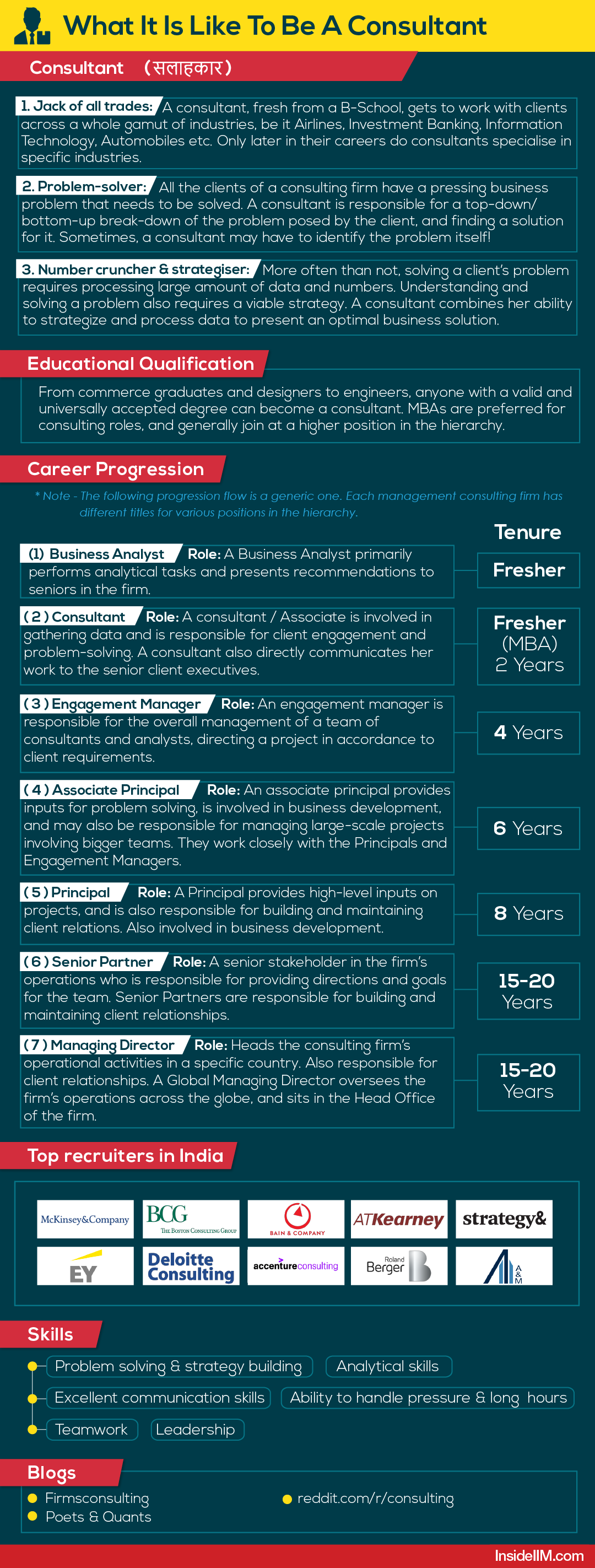Consulting - One of the most sought-after domains post-MBA is also one of the most enigmatic.

What is it that a Consultant really does? What is the career progression like at a Consulting firm? Which are the
top companies to work for as a Consultant? What are the skills and qualification required to become a consultant? Where does the glamour of being a Consultant emanate from?
In this article, we will take a holistic (albeit generic) look at the life of a Consultant, while attempting to answer the aforementioned questions. To make things easier to understand, I will provide numerous real-life examples from the life of a Consultant, as well as other resources to help you understand this domain better.

Now, let us take all of this information and compare it with the life of a Management Consultant specialising in Technology.
The life of a Consultant can be broadly segmented into 3 stages -
- Before you get a deal.
- When you're at the client site.
- Fag end and Conclusion of a project.
Before You Get A Deal -
Before a Consultant gets a deal, he/she has to prepare multiple proposals that need to be sent out to a prospective client.
- Prior to the proposals, a client sends out a Request For Proposal (RFP), also called the Standard Request For Proposal (SRFP), which is essentially an invitation to a firm to submit a proposal/set of proposals for a consulting assignment.
To understand what an RFP looks like and what it comprises of, click here.
- A Consultant also works on capacity/capability building in new areas of technology, which can be of use to the client as well as for future projects.
- They also attend review meetings to understand various internal activities for the purpose of internal knowledge sharing.
At The Client Site -
- After the deal is confirmed, a Consultant conducts a client stakeholder workshop to understand the requirements of the client.
- In these workshops, the client provides the Consultant with documents and data that will be crucial for understanding the problem statement of the client.
- A Consultant then studies this data and identifies the key pain-points of the client and why the client needed consulting.
- After identifying the problem(s), the Consultant then conducts multiple meetings with internal stakeholders to discuss probable solutions for the client's problem(s). Here, the teams are also assigned to (including Consultants with various areas of expertise) be included in the solution building process.
- After the teams have been assigned, team members are assigned various roles and responsibilities based on their competencies and area of expertise. The team conducts extensive research on internal and external information.
- Consultants also refer to solutions provided to other clients who may have had a problem statement similar to that of the current client. They assess the applicability of those solutions to the current situation.
- A Consultant then conducts research on industry trends and benchmarks.
- After a lot of discussion and brainstorming, the team then formulates the first draft of the solution that the firm is offering. This solution is then run through internally, where senior members of the firm assess the viability of the solution and the probability of acceptance by the client.
- Upon approval, the solution is provided to the client, who gives his/her feedback on the solution. The Consultant takes a note of the feedback and identifies the caveats provided by the client (if any).
All this while, the client is kept in the loop with every update that the team comes up with.
Conclusion Of A Project -
After the caveats have been identified, the team refines the solution and conducts more client workshops if required.
The final solution is then presented to the client and the sign-off is received.
Some consulting firms are also involved in the implementation of the solution offered if requested by the client.
Consulting is considered to be an intellectual profession, therefore it is of paramount importance that a Consultant remains updated with industry trends by attending various seminars, workshops and internal training programmes (within the firm).
To understand the life of a Consultant better, here are some resources -

- Why Consulting? | McKinsey Diaries




